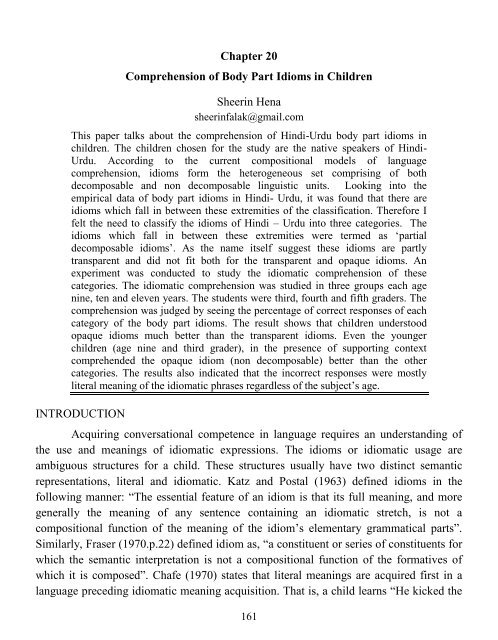coalescence - sconli
coalescence - sconli
coalescence - sconli
Create successful ePaper yourself
Turn your PDF publications into a flip-book with our unique Google optimized e-Paper software.
Chapter 20<br />
Comprehension of Body Part Idioms in Children<br />
Sheerin Hena<br />
sheerinfalak@gmail.com<br />
This paper talks about the comprehension of Hindi-Urdu body part idioms in<br />
children. The children chosen for the study are the native speakers of Hindi-<br />
Urdu. According to the current compositional models of language<br />
comprehension, idioms form the heterogeneous set comprising of both<br />
decomposable and non decomposable linguistic units. Looking into the<br />
empirical data of body part idioms in Hindi- Urdu, it was found that there are<br />
idioms which fall in between these extremities of the classification. Therefore I<br />
felt the need to classify the idioms of Hindi – Urdu into three categories. The<br />
idioms which fall in between these extremities were termed as „partial<br />
decomposable idioms‟. As the name itself suggest these idioms are partly<br />
transparent and did not fit both for the transparent and opaque idioms. An<br />
experiment was conducted to study the idiomatic comprehension of these<br />
categories. The idiomatic comprehension was studied in three groups each age<br />
nine, ten and eleven years. The students were third, fourth and fifth graders. The<br />
comprehension was judged by seeing the percentage of correct responses of each<br />
category of the body part idioms. The result shows that children understood<br />
opaque idioms much better than the transparent idioms. Even the younger<br />
children (age nine and third grader), in the presence of supporting context<br />
comprehended the opaque idiom (non decomposable) better than the other<br />
categories. The results also indicated that the incorrect responses were mostly<br />
literal meaning of the idiomatic phrases regardless of the subject‟s age.<br />
INTRODUCTION<br />
Acquiring conversational competence in language requires an understanding of<br />
the use and meanings of idiomatic expressions. The idioms or idiomatic usage are<br />
ambiguous structures for a child. These structures usually have two distinct semantic<br />
representations, literal and idiomatic. Katz and Postal (1963) defined idioms in the<br />
following manner: “The essential feature of an idiom is that its full meaning, and more<br />
generally the meaning of any sentence containing an idiomatic stretch, is not a<br />
compositional function of the meaning of the idiom‟s elementary grammatical parts”.<br />
Similarly, Fraser (1970.p.22) defined idiom as, “a constituent or series of constituents for<br />
which the semantic interpretation is not a compositional function of the formatives of<br />
which it is composed”. Chafe (1970) states that literal meanings are acquired first in a<br />
language preceding idiomatic meaning acquisition. That is, a child learns “He kicked the<br />
161


